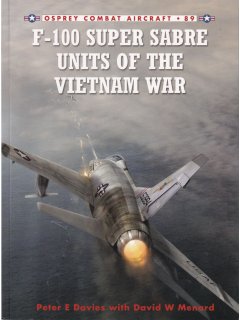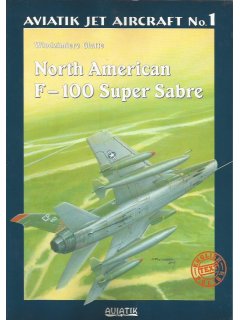F-100 Super Sabre Units of the Vietnam War, Combat Aircraft 89, Osprey
- Brand: Osprey
- Product Code: COM89 [23959]
- Availability: Available upon request within 20 - 40 days.
- Date added: 29/09/2022
This product belongs to the following categories:
-
20.80€
The F-100 Super Sabre may have been superseded by the superior technology of the F-105 Thunderchief and the F-4 Phantom by the Vietnam War it remained in service. The Super Sabre was deployed as an air defence fighter, and was later given nuclear capability. The F-100's toughness, adaptability and reliability made it ideal for the incessant missions that were demanded by close support and counter-insurgency missions. 242 Super Sabres and 87 aircrew were lost during the war but their role, particularly in developing the tactics used for discovering and destroying SAM sites, was invaluable.
This book describes some of the most important actions that the F-100 took part in, looks at the pilots who flew it and analyses the impact of the aircraft on the war.
Contents:
- Chapter 1
A very brief account of the design philosophy and development of the aircraft from the F-100A day fighter driven by Korean War needs, through the F-100C which provided Tactical Air Command's contribution to the nuclear deterrent, to the improved F-100D, the workhorse for Tactical Air Command world-wide and its war-horse in South Vietnam. Early deployments to Don Muang Airport, Thailand, in April 1961 in response to Pathet Lao incursion are followed by squadron-size deployments to Takhli RTAFB in 1962 and the first combat missions from Da Nang, South Vietnam, in June 1964. - Chapter 2
In response to the Gulf of Tonkin incident, more F-100Ds fly escort missions from Da Nang for reconnaissance flights over Laos and South Vietnam. Combat air patrols over the Gulf of Tonkin bring many near-engagements with MiGs, while the first loss on an attack mission in Laos occurs in August 1964. Super Sabres begin Operation Barrel Roll missions, including hazardous attacks on anti-aircraft sites, and fly fighter cover and flak suppression for F-105 strikes in Operation Flaming Dart. In November 1965 Operation Rolling Thunder involves three squadrons of F-100s as MiGCAP and flak suppression elements. F-100D pilot Lt Hayden Lockhart becomes the first USAF prisoner of war in Hanoi. Attacks on the Than Hoa and Ham Rong Bridges involve five flights of F-100s and a probable MiG kill for Capt Kilgus. F-4C Phantom IIs arrive and replace F-100s in the MiGCAP role. - Chapter 3
Four airbases are built or expanded in South Vietnam to house three tactical fighter wings equipped with F-100s for the ‘in-country' war, leaving only five F-100 squadrons in the USA. Intensive close-support missions are flown, including challenging night missions over the Ho Chi Minh trails. Pilots pride themselves on their accuracy and the frequency of their missions. The chapter will discuss the F-100's flying and fighting characteristics and the conditions and support networks at the relevant airbases. - Chapter 4
The conversion of F-100F airframes provided the USAF with its first Wild Weasels, pioneering SEAD techniques that are still in use and developing the equipment to defeat enemy radars and radar-guided missiles and guns. Training is carried out in great secrecy and four modified F-100Fs begin to operate from Korat RTAFB with F-105 bombers, destroying heavily defended SAM sites close to Hanoi. Missions continue until July 1966. - Chapter 5
‘Misty' FAC
The Commando Sabre detachment at Phu Cat AB provides high-speed FAC for air strikes from 1967 to May 1970, flying some of the most dangerous missions of the war and suffering heavy losses. They also fly combat air patrols for rescue missions searching for aircrew shot down in hostile territory. Once again the F-100 and its crews develop and introduce new battle techniques that are still part of today's aerial warfare tactics. - Appendices:
F-100 deployments to Southeast Asia: units, dates and bases, with commanding officers listed.
F-100 specifications, performance and armament details
F-100 combat losses
Authors: Peter E Davies, David W Menard
Illustrator: Rolando Ugolini
Publisher: Osprey Publishing
Description: 96 pages, Paperback, 247 X 184 mm.
Condition: NEW COPY
Shipping weight: 470 gr.
Related Products
North American F-100 Super Sabre
AVIATIC JET AIRCRAFT, Book No.1: NORTH AMERICAN F-100 SUPER SABRE. Author: Wlodzimierz Glatte ..
19.00€ Ex Tax: 17.92€


